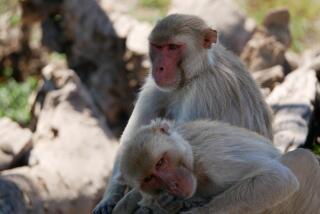The Ability to Detect a Lie May Have Evolved From Primates
- Share via
The human ability to look people in the eye and tell if they’re lying may have evolved from our primate ancestors, suggests a study published in the current issue of the journal Nature.
A threatening bark or a friendly coo is often enough to allow monkeys to determine the meaning of such calls but -- like humans -- sound alone doesn’t seem to be the only clue monkeys use to discover the implications behind these auditory expressions.
Rhesus monkeys, a species that displays a wide range of elaborate facial expressions, are able to link threatening and cooing sounds to the appropriate monkey face, said Asif Ghazanfar, a scientist at the Max Planck Institute for Biological Cybernetics and lead author of the Nature article.
The study found that when monkeys were presented with two videos -- one of a monkey making the face associated with the threat call and the other a coo call -- but were given only the audio for one of the videos, the monkeys would spend more time looking at the video that corresponded to the correct facial expression.
“What studies like this show is that language is really multi-modal -- our brains evolved to integrate speech and gesture and facial expressions,” said Michael Arbib, a professor of computer and neuroscience at USC.
Studies show that children who have not yet learned to talk will respond in a similar manner to an analogous test for humans. When considered together, the human and monkey studies suggest that the ability to match a person’s facial expression to an associated phrase may have evolved from primates.




